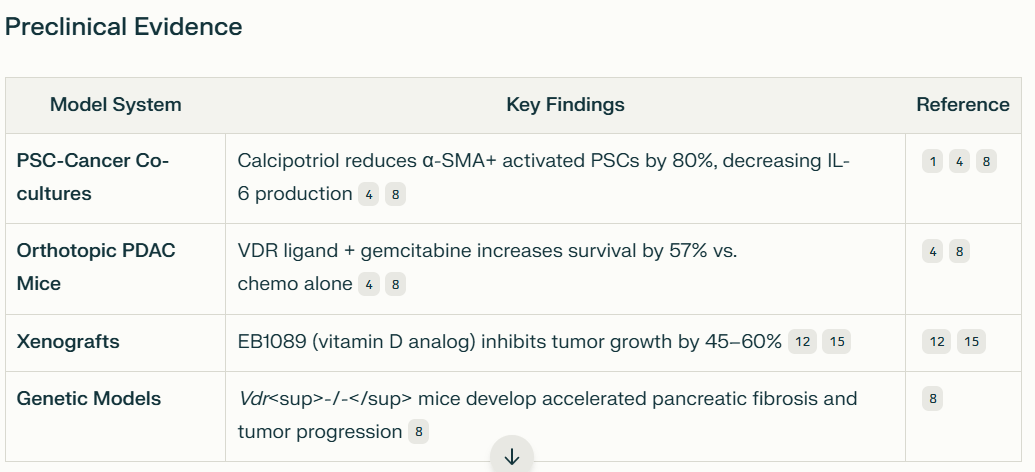Unexpected Remission
A patient with advanced Pancreatic Cancer received her Vitamin D in the mail. She received 50,000 IU soft gels, an unusually high dose designed to be taken only once per week.
However, she began taking them daily instead, and this correlated with her unexpected remission from the cancer despite less than one cycle of chemotherapy.
By the time her physicians discovered the “error,” her Vitamin D level had climbed to 150 ng/ml, yet she was feeling better than ever with no ill effects. More on this below.
Dr. Stephen Bigelsen’s Remission
We recently reported on the remarkable case of Dr. Stephen Bigelsen who combined Paricalcitol with IV Vitamin C and achieved a complete response from Stage 4 Pancreatic Cancer.
Paricalcitol is a Vitamin D analog which can bind the Vitamin D Receptor [VDR]. The possible advantage over Vitamin D is that it has a lower potential for inducing hypercalcemia, although studies have shown there is a greater risk for adverse effects associated with Paricalcitol than with high-dose Vitamin D.
For this reason and others, Dr. Marik and I removed Paricalcitol while favoring high dose Vitamin D in our Pancreatic Cancer Protocol which is attached here.
We believe that the high-dose Vitamin D - The Coimbra Protocol - may be superior as it is cheaper, does not require hospitalization, and is safer. Here is the comparison and summary of Paricalcitol versus high dose Vitamin D:
Notice the less than 1% risk of hypercalcemia with Coimbra compared to the 13 to 19% risk of grade 3/4 adverse effects with Paricalcitol.
Patients on the Coimbra Protocol are monitored closely with blood testing of calcium levels, renal function, and parathyroid hormone levels every three months.
Typical Coimbra Vitamin D doses are 35,000 to 50,000 IU per day, although in some cases of Vitamin D resistance doses up to 300,000 IU have been employed.
Both Vitamin D and Paricalcitol bind the VDR. The VDR is overactive in Pancreatic Cancer and plays a role in the maintenance of this deadly cancer’s stromal matrix.
Binding of VDR by either Vitamin D or an analog suppresses the activity of TGF Beta, a CSC growth pathway. VDRs are concentrated within the cancer stellate cells located within the stroma of pancreatic ductal adenocarcinoma.
Albrechtsson et al. found a more than threefold increase in human cancer cell lines than the normal pancreas. The stroma, consisting of fibroblastic cells, immune cells, blood vessels and matricellular proteins, plays a crucial role in promoting and sustaining tumor growth.
Saturating the Vitamin D receptors with either an analog or Vitamin D should therefore, in theory, suppress the tumor growth, particularly within the stroma.
And the studies and case reports are consistent with this:
How Vitamin D Fights Pancreatic Cancer’s Stromal Defense:
Vitamin D exerts multimodal effects in pancreatic cancer through vitamin D receptor (VDR)-mediated pathways:
Stromal Reprogramming
VDR activation reverses pancreatic stellate cell (PSC) activation, reducing fibrosis and inflammation. Calcipotriol (a vitamin D analog) decreases ECM deposition by 40–60% in preclinical models, enhancing gemcitabine penetration.
This stromal normalization decreases tumor-promoting cytokines (IL-6, CSF2) and increases anti-tumor immune infiltration.
Suppressing Metastases - Epithelial-Mesenchymal Transition (EMT)
VDR signaling downregulates FOXM1, a master EMT regulator, reducing metastasis in PDAC xenografts by 70%. 1,25D suppresses Snail/Slug pathways, restoring E-cadherin expression in vitro.
Immunomodulation
Vitamin D enhances CD8+ T-cell infiltration while reducing immunosuppressive Tregs. Preclinical data show 1,25D increases PD-L1 expression, potentially synergizing with checkpoint inhibitors.
Unexpected Pancreatic Cancer Remission with 50,000 Units of Vitamin D Daily - Full Case Report:
Keep reading with a 7-day free trial
Subscribe to Repurposed Drugs: Powers & Possibilities to keep reading this post and get 7 days of free access to the full post archives.







